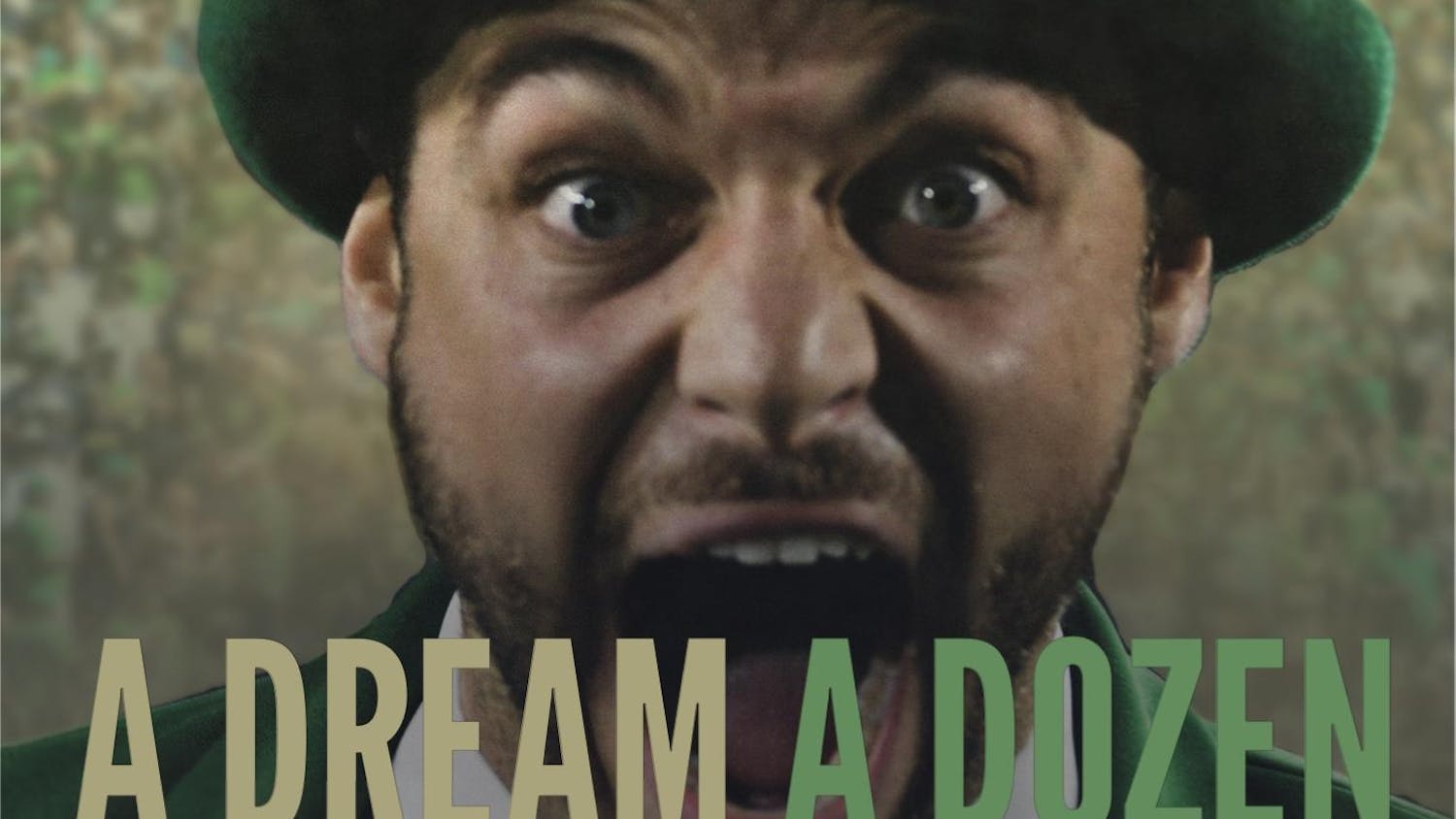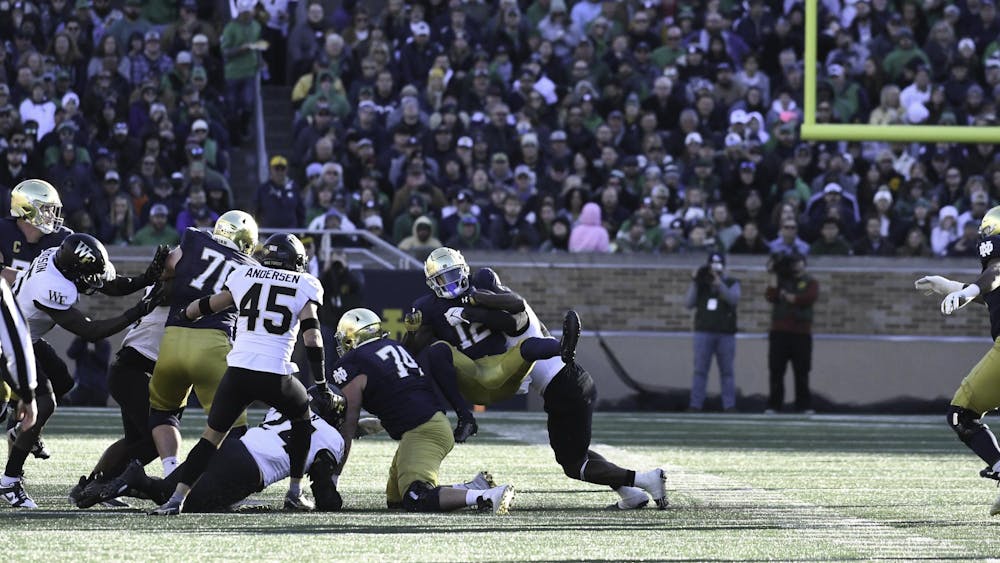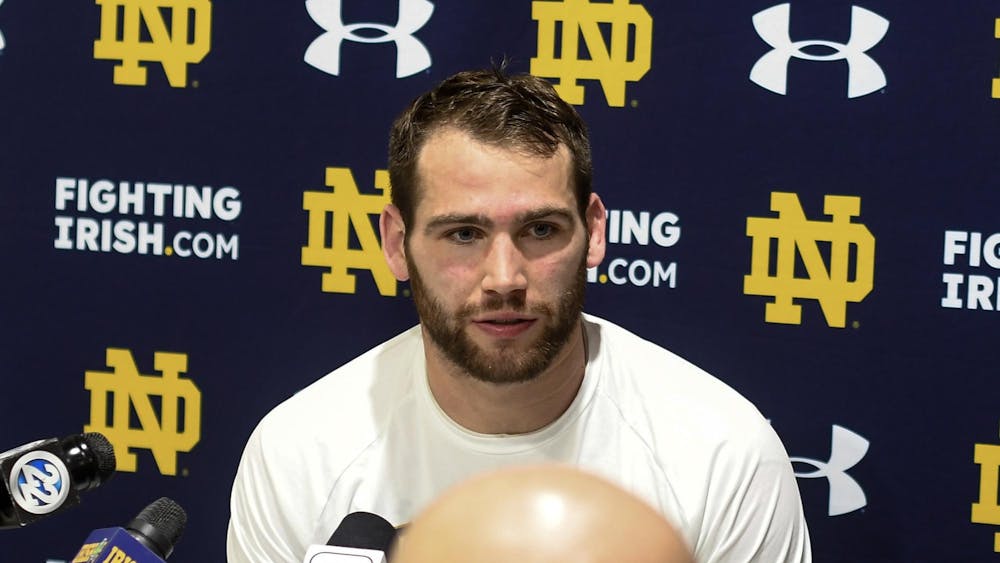With the end of the home football season came the beginning of the highly anticipated Campus Crossroads construction, a nearly three-year plan to transform and expand the outside of Notre Dame Stadium that develops both athletic and academic endeavors.
Notre Dame Director of Athletics Jack Swarbrick told The Observer in an interview Dec. 18 that the process has gone smoothly from all he has seen and heard.
“It’s amazing,” he said. “I’m not close enough to [the construction process] to answer that question effectively. But given the relatively good weather we’ve had — if you remember last year at this time, we were buried in massive snow — and just the rate at which they’re working outside my window, it feels like it’s going very well.”
Despite the work closing off a large portion of the Joyce Center parking lot, along with much of the walking area around the Stadium, Swarbrick said the feedback he has received has been mostly positive.
“By and large, people have been remarkably good-spirited about it,” he said. “We are creating more circuitous walking paths to some extent [and] they have been great.
“We’ve had some complaints related to parking during our events. We’ve obviously lost some parking spaces, and it’s a little more complicated, but as people have gotten used to the routine of that, I’ve sensed, again, a willingness to make accommodations because they realize the broader gain that’s being achieved here.”
Since it will not be finished in time for the kickoff of the 2015 football season against Texas on Sept. 5, Swarbrick said construction will take a break during the fall.
“The construction fences get pulled back in, parking gets recaptured,” he said. “There will be a metal superstructure in place, but it won’t interfere at all with game day.”
Beefing up the football schedule
The Irish football program continued to spread its nationwide footprint, scheduling future series with Ohio State and Texas A&M this fall.
Swarbrick announced Sept. 4 that Notre Dame will take on the Buckeyes in a two-game, home-and-home series in 2022 and 2023, while the Irish will face the Aggies in the same format in 2024 and 2025, he said Sept. 25.
Swarbrick pointed out that Notre Dame’s previous commitments — five ACC games per year, annual contests against USC, Stanford and Navy and the yearly Shamrock Series matchup — limit the amount of outside teams the Irish can schedule to only one home and one away game per year.
“We want to use those two spots to build the best strength of schedule we can, but also get Notre Dame around the country,” Swarbrick said.
He also said the increased focus on strength of schedule, stemming from the new College Football Playoff, made securing the new series “easier than [it] used to be,” because other teams are eager to beef up their non-conference slate.
He added that Notre Dame’s lack of a conference championship game does give the Irish a disadvantage in the playoff selection process.
“That means we have got to make a compelling case for our inclusion,” Swarbrick said. “… Our job is to make sure our 12 games create a compelling enough story, relative to the Selection Committee’s analysis, that they will still be comfortable picking us, notwithstanding the absence of a 13th game.”
At the same time, Swarbrick said he recognizes there are areas of the Playoff system that can be discussed and improved, and he will have the chance to take part in those talks when the Playoff Management Committee — of which Swarbrick is a member — meets with the Selection Committee in January.
“We’ll learn from that [meeting],” he said. “I must say, I couldn’t be more pleased with the way the Selection Committee operated. … It felt like they got the final four right. So I think the process worked very well.”
Coaching changes — and shows of support
After starting the season 6-0, the Irish football team closed its regular season with a 7-5 record, dropping five of its last six games.
With three of those losses coming down to four points or fewer, some critics attributed the defeats to coaching errors on the part of head coach Brian Kelly. Despite this negative feedback, Swarbrick said Kelly is far from being on the hot seat.
“He’s on a very cold seat,” Swarbrick said. “… I think the foundation of the program is as strong as it’s been in my seven years here. In terms of the quality of the players, the depth, the services that support football, in terms of strength and conditioning, nutrition, medical services, our facilities, the foundation is in great shape.”
Swarbrick added Kelly’s performance as head coach during his five-year stint with Notre Dame has been consistent with his expectations when he brought Kelly in.
“[We’ve had] a national coach of the year, a national championship game and some very key victories,” he said. “We’d all like to win a national championship, but if you told me five years ago when we made the decision, ‘Here’s what you’re going to accomplish, and here’s what your record is going to be,’ I would be okay with that, notwithstanding the struggles of the second half of this season.”
Football was not the only Notre Dame team that struggled this fall. The Irish volleyball program had its worst season in 24 years, recording a 6-23 mark. On Dec. 4, less than a week after the season wrapped up, Swarbrick announced that Debbie Brown, the team’s head coach for nearly a quarter-century, would not return in 2015.
Swarbrick said that Brown’s departure after the first two losing seasons of her tenure is not an indication of his expectations for other sports.
“Every program is different, and you evaluate them individually,” he said. “ … Our coaches know that their programs are evaluated individually and independently of each other. I count on them being comfortable that they understand our view of their program from our discussions, and they know what our expectations of each program are.
“Our expectations of each program are not the same. Some programs are better positioned to pursue national championships than others. There’re a host of issues that come into play at a place like this, as to what a sport’s ultimate upside is and what it can achieve.”
In addition to Brown, two other head coaches left Notre Dame this semester. Women’s swimming coach Brian Barnes resigned Sept. 2 to spend more time with his family, while fencing coach Janusz Bednarski retired Dec. 2.
While associate head coach Gia Kvaratskhelia immediately took over for Bednarski, Swarbrick said he is still searching nationally for permanent replacements for volleyball and women’s swimming.
Swarbrick said he expects to hire a new volleyball coach relatively soon, while the search for the women’s swimming coach has been delayed by NCAA rules prohibiting Notre Dame from approaching other schools’ coaches until the new year.
Women’s basketball takes a stand
In the final days of the fall semester, the Irish women’s basketball team made national headlines when the players warmed up for their game against Michigan on Dec. 13 wearing “I Can’t Breathe” shirts in support of Eric Garner and his family.
The team, led by sophomore forward Taya Reimer, made the decision with the support of coach Muffet McGraw and Swarbrick, he said.
“There were several things that were important to me,” Swarbrick said. “One was that it’d be a team decision. That all of the team participate.
“Two, that they were able to articulate the motivation, notwithstanding the interpretation of it. It wasn’t anti-anything. It was an expression of an interest in promoting social justice broadly, and I thought Muffet’s postgame statement captured that brilliantly.
So understanding the rationale, knowing that all members of the team were on board, I’m generally going to be supportive, because my individual views are less important than our embracing the interest of our student-athletes in doing what all students ought to be doing: thinking about these issues, talking about them, taking positions on them. … This wasn’t top-down driven.”
Future issues for players
In an interview last spring with The Observer, Swarbrick said he wanted to find new ways to incorporate student-athletes into decision-making processes in the athletics department. Since then, he said, progress has been made toward that goal.
“We’ve created a Steering Committee for Notre Dame Athletics,” he said. “It involves some executive staff members, members of the faculty-athletic board [and] … seven student-athletes. And this will be the group that looks broadly at Notre Dame athletics and some of the things we’re doing and helps both steer our future course and discuss some of the key decisions we need to make.
It will start meeting second semester. We’ve used the first semester to define its charter and set it up.”
With a decision upcoming in the Northwestern unionization case, Swarbrick, a former labor lawyer, reiterated Notre Dame’s stance against any form of unionization but added that he thought the issue was not the most pressing in collegiate athletics.
“We disagree strongly with the conclusion [of the initial Northwestern ruling],” he said. “… When I read the opinion, I’m amazed at some of the assumptions it makes. It draws from the fact that the student-athletes were, for example, required to live in dorms or do some other things, to say that they’re employees. Those are things that define them as students for me, not employees.
“ [But] I don’t think unionization is the major issue we’ll face going forward. It’s working our way through the things we’re starting to tackle at the NCAA regarding the relationship between student-athletes and the University and some of the benefits they get.”
Swarbrick is one of the few athletic directors of an NCAA institution to publicly support allowing student-athletes to profit off their likenesses. He said his reasoning for this position is based on his desire for student-athletes to have an experience like that of any other student.
“[Any non-student-athlete] could go maximize their image or likeness, independent of their schoolwork, if you have a talent — you were a musician or an actor or something else, or you wanted to launch a business,” Swarbrick said. “So the question becomes, why shouldn’t student-athletes be able to do that? You have to manage it in a way that avoids abuse in the case of sports, but I think that’s doable without prohibiting it. So that’s what I think we have to be talking about.”
First seasons for Under Armour, FieldTurf
Two highly hyped changes came to Irish athletics during the fall seasons, with the new Under Armour footwear and apparel contract and FieldTurf in Notre Dame Stadium making their debuts.
Swarbrick said the switch from Adidas to Under Armour has gone smoothly, and he has received positive feedback, especially from athletes.
The deal, valued by some at around $90 million, is the most expensive in college sports and has included collaborations between the company and the University that Swarbrick labeled a “home run.”
Specifically for football, the Irish welcomed visiting opponents to games on the stadium’s new FieldTurf, a departure from the natural grass surface that had previously been in place.
While the adjustment garnered criticism from some alumni and traditionalists, Swarbrick said the move was worth it.
“It looks better; it represents Notre Dame better, but it just is more playable,” he said. “And when you look at the weather we had this year, we would have had a disaster chasing that field all year. We were so lucky to get it in for this season because this one really would have tested it.”













